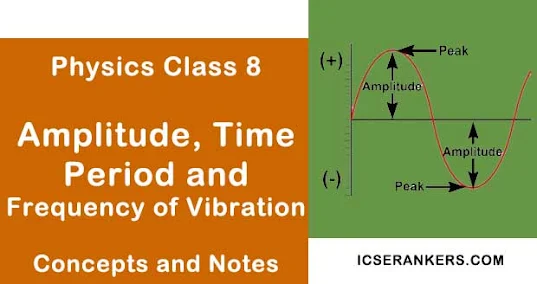Amplitude, Time Period and Frequency of Vibration- Physics Guide for Class 8
Information about Amplitude, Time Period and Frequency of Vibration
Title | Amplitude, Time Period and Frequency of Vibration |
Class | Class 8 |
Subject | Class 8 Physics |
Topics Covered |
|
Amplitude, Time Period and Frequency of a Vibration
On observing a vibrating body carefully, we see that it moves, 'to and fro', about some central position, in a regular periodic manner. This regular periodic nature of vibrations is most easily observed by looking at the swinging bob of a simple pendulum. The swinging bob goes only up to a certain position on either side of the central position.
- A vibrating body has a maximum displacement on either side of its central position. This maximum displacement of a vibrating body, on either side of its central position, is called its amplitude.
- It is also observed that the vibrating body completes its one cycle, of 'to and fro' motion, in a fixed time interval. This time interval is called its time period.
- A vibrating body completes a fixed number of cycles of vibration in one second. This number is known as its frequency.
- The amplitude of a vibration can be measured in units of distance/length. Therefore, its SI units is metre. Likewise, the time period of a vibrating body is measured in units of time. Therefore, its SI unit is the second. The SI unit of frequency is hertz.
Loudness and Pitch of a Sound
The amplitude of a sound determines its loudness. More the amplitude of vibration, the louder is the sound produced. It can be easily checked by using a drum. If we strike the drum lightly with its stick, we get only a faint sound.
- However, if we strike the stick with some extra force, we get a loud sound. The frequency of a sound determines its shrillness or flatness.
- The word pitch is used to describe the shrillness or flatness of a sound. A higher pitch (i.e. a higher frequency) means shriller sound while a lower pitch (i.e. a lower frequency) means a flatter sound.
Activity 1
We can easily demonstrate the effect of frequency on the pitch of sound by taking a cycle. Make the cycle stand on its support and rotate its back wheel very slowly. Now, let a knitting needle touch the spokes of this rotating wheel.
You will hear a flat (low pitch) sound. However, if the wheel is rotated fast, the needle and the spokes produce a shrill (high pitch) sound.
- In the case of human beings, the voices of females and children have a higher frequency than those of males. The male voice is flatter (i.e. has a lower pitch) than the female voice or the child's voice.
Audible and Inaudible Sound
It is clear that vibrations cause sound. But is the reverse true? Do we always get a sound whenever there are some vibrations? Let us do some activities to find this out.
Activity 2
Take a drum and strike its membrane very lightly with its hammer. The membrane starts vibrating. However, if we ask someone, standing at a distance, as to whether she/he hears a sound, the answer is likely to be 'No'.
Why?
We can say that this is so because the sound produced, in this case, is a very faint sound. We, thus, realise that a sound, if it is not loud enough, may not be heard by us. We call such a sound as an inaudible sound.
Activity 3
Take a simple pendulum, of about one metre length. Allow the bob of the pendulum to oscillate. The bob starts oscillating. Do we hear any sound in this case?
The answer is again 'No'. Why?
- Experience, and repeated observations, reveal that if the frequency of a vibrating body is less than 20 cycles per second, or 20 hertz, its vibrations do not produce any audible sound.
- Thus vibrations, of frequency less than 20 cycles per second, are again inaudible sounds. We also call them as infrasonics.
- It turns out that even very high frequency vibrations do not produce audible sounds. These are vibrations of frequency more than 20,000 Hz or 20 kHz. We call them as ultrasonics.
The human ear thus recognises only those vibrations as audible whose frequency value lies between (nearly) 20 Hz and 20,000 Hz.
- We, thus, condude that, the audible range of frequency of sound, for human beings, extends from about 20 Hz to about 20,000 Hz (20 kHz).
- Sounds of frequencies below 20 Hz cannot be detected by the human ear. Such sounds are called infrasonic sounds and are inaudible to us.
- Sounds of frequencies higher than 20,000 Hz are called ultrasonic sounds or ultrasounds. They are again inaudible to the normal human ear.
Some Important Points
- Loudness of sound depends on the square of the amplitude of the vibrations producing that sound. Its unit is the bel (B). We also often use the unit decibel (dB) where a decibel = 1/10 bel. The faintest sound which a human ear can detect is known as the threshold of hearing. The threshold of hearing is assigned a sound level of zero decibel. Loudness of sound from different sources
- Whales and elephants produce sound in the infrasonic range. It is also observed that some animals get disturbed before an earthquake. Earthquakes produce low frequency infrasounds before the main shock waves are 'released'. It is this feature that possibly alerts these animals of an impending earthquake.
- Ultrasounds are produced by dolphins, bats and porpoises.
- Dogs have the ability to hear sounds of frequency much higher than 20 kHz. Police teams often use high frequency (Galton) whistles which dogs can hear but humans cannot.
- Now-a-days we use ultrasound equipment for investigating and tracking many medical problems.





